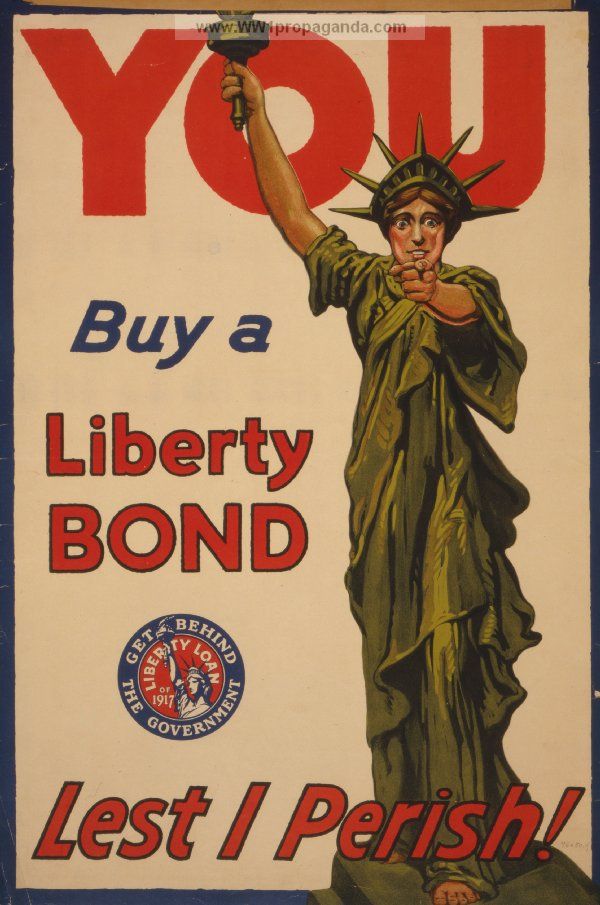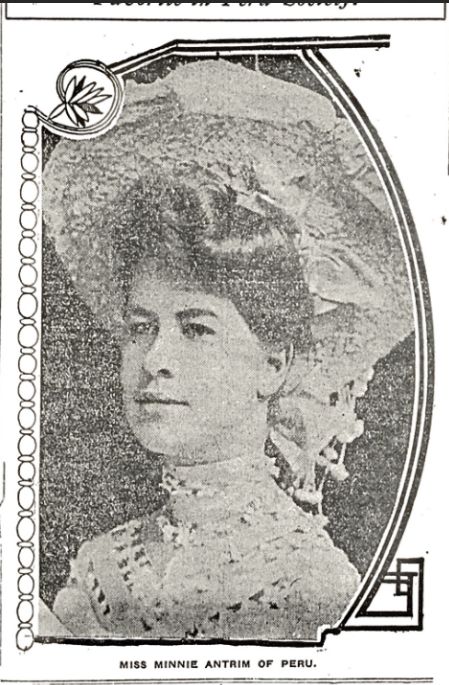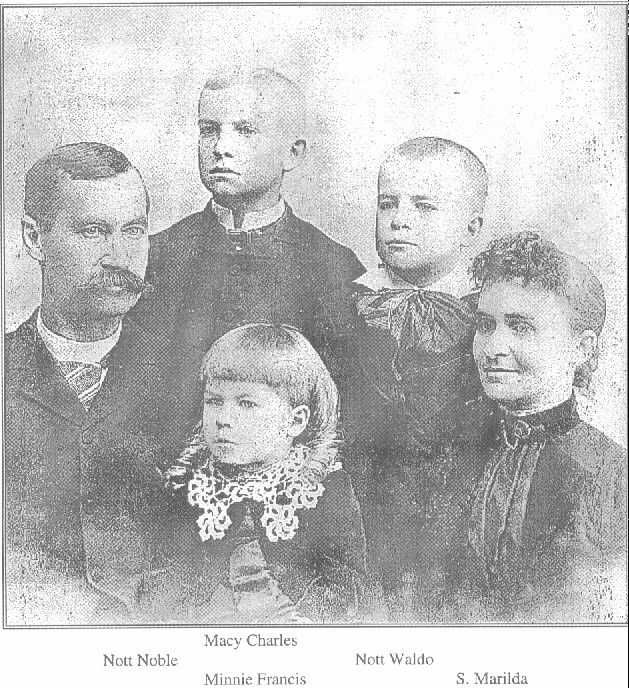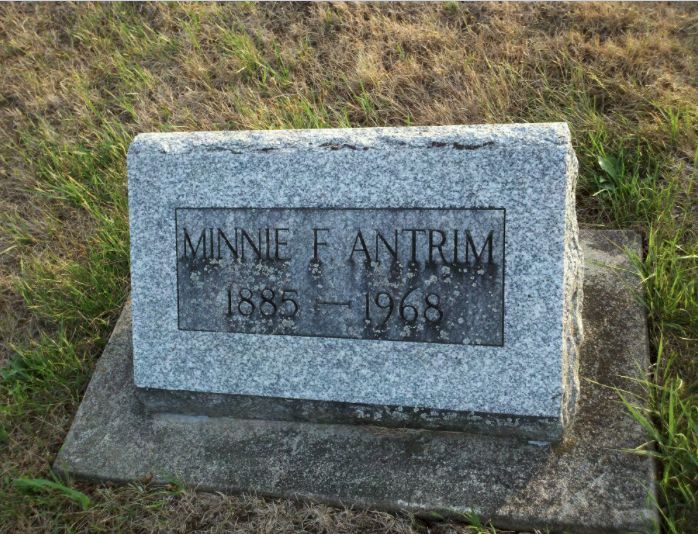The child reached as high as she could with her small hand
outstretched. Her chubby little arm was extended to its maximum
reach as her fingers grasped at the piece of paper floating down
through the air towards the ground. Her cheeks were flushed with
excitement and she squealed with joy as she opened the bright leaflet
she caught in the breeze. Her brother grabbed a paper too, as did
the other people who were standing around her family.
Everyone’s eyes were lifted skyward as they watched the airplane sail
across the sky, dropping pamphlets down on the small city of Peru,
Indiana. It was two o’clock in the afternoon on September 21,
1918. She could not read what was written on the colorful paper
she clutched, but she heard her father’s voice ring out as he read the
words that were printed across the pamphlet.
“BUY YOUR LIBERTY BONDS NOW!”

When the United States became involved in WWI
there was debate by the country’s leaders in Washington D. C. over how
to finance the cost of the war. Savings bonds were chosen as a
tool to cover part of the expense. These savings bonds were
called “Liberty Bonds” and were used to supplement taxes and generate
income while at the same time they would encourage American’s to
save. A three-prong plan was devised to accomplish these
goals. The first task was to educate the public about the bonds,
including information about the causes and effects of war and the
financial power of the country. The name “Liberty Bonds” was part
of this educational plan. The second prong was an appeal to
patriotism asking everyone to do their part to decrease consumption and
increase savings by purchasing bonds. The third part of the
plan was the bonds were to be sold by volunteers to avoid a paid sales
force. The volunteers on the committee in Miami County, Indiana
involved in carrying out these three tasks had set up a community event
for the weekend of September 20 through 22 in 1918.
A plane had been secured to arrive at the
Country Club outside of Peru on Friday at five p.m. Members
of the Mississinewa Country Club were invited to watch flying
exhibitions during the early evening hours. The plane was known
as a “Jenny" which was an abbreviation of the proper name - Curtiss
JN-4. These planes were used during WWI to train fighter
pilots. 95% of the airman trained to fly at that time were
trained on the Jenny. There was a combined total in excess of
8000 Jennys built at six different manufacturing locations. They were
used by the military from 1916-1927. Often referred to as the
Model T-Ford of the air, the Jenny’s wingspan was over 43 feet.
She was more than 27 feet long and exceeded 9 feet in height.
When empty the plane weighed nearly 2000 pounds. To see an
airplane in 1918 was uncommon, so this event to raise awareness and
promote sales of the Liberty Bonds was an exciting
occurrence. It was a very special occasion for the people
of Miami County to see a Jenny that fall weekend. On Saturday
afternoon, starting at 1:50 pm, Liberty Loan circulars were released
into the sky by the pilot, Lieutenant Johnson of the U.S. Aviation Army
Corps, while he exhibited the plane, flying over the streets and houses
of Peru. The next day, on Sunday, the Jenny was on display at the
Country Club, which was open to the public, so people could see the
plane up close, and also meet Lieutenant Johnson. Afterwards he
flew the plane back to St Louis.
|

The individual
who was given the credit for persuading Lieutenant Johnson to lend his
time and talent, as well as for him to obtain the military plane for
the Liberty Bond event in Miami County, was a young woman named Minnie
Antrim. She was from a well-known Miami County family. Her
paternal grandfather had been born in Clinton County, Ohio and at some
unknown date had migrated to Cass County, Indiana. When her
father, the esteemed Nott Nobel Antrim, was ten-years old he was
orphaned. Nott lived with an older brother for two years and
then, striking out on his own, worked his way through school and became
a lawyer. Later he was elected to the state legislature.
Nott married Minnie’s mother, Marilda Adkisson, in 1875. Minnie’s
brother, Nott W, was born in 1881 and Minnie was born in 1886.
Tragically in 1894 Marilda Antrim died.

Nott Nobel remarried and the children were raised by their step-mother,
Ida Bell Armstrong Antrim. As a young woman, Minnie taught music
while living in her father’s Peru Township home. Her involvement
in civic affairs is first noted in June of 1917 when she is listed as
one of the two officers who were registering women to vote in Miami
County Indiana. But by 1918 the St Louis City Directory lists
Minnie as employed as a stenographer with Mallinckrodt Chemical Works.
The Peru paper, in September of that year, when reporting of the
upcoming event involving the Liberty Bond Airplane, refers to Minnie as
being “stationed at St Louis”. At this time, no proof of a
military involvement has been found for Minnie. So, what was she
doing in St Louis at the Mallinckrodt Chemical Works?
After the war, Minnie remained in St. Louis,
where she began working for the Wabash Rail Road as a
stenographer. She was promoted to a clerk in 1922. Tragedy
touched Minnie’s life when her father died in 1931. Although
continuing to live in St Louis through 1935, Minnie had moved on by
1940 when, always on the cutting edge of popular trends, Minnie was
living at the Warwick Allerton Hotel working as a radio clerk.
Don McNiel was broadcasting from the Tip Top Lounge on the 23rd floor
of the Warwick Allerton on the ABC Radio Network at that time,
therefore it is likely that she was a clerk for ABC Radio
Network. Minnie suffered another significant loss when her
brother died in 1956. She must have retired to Hot Springs National
Park in Garland County, Arkansas because in 1960 she can be located by
her involvement in a legal dispute over real estate property.
Three years passed and at age 77, she was photographed taking a Spanish
foreign language class at the Hot Springs YWCA. Five years later,
Minnie passed away while still living in Arkansas. Her body was
brought back to Miami County and on December 24, 1968, graveside
services were held for her at Mount Hope Cemetery in Peru,
Indiana. Minnie was one of the women who were the movers and the
shakers in Miami County during the WWI era. Credited with
procuring the main attraction for the Liberty Bond event at the Country
Club in 1918, she is certainly a part of Miami County, Indiana that is
“worth remembering".
Researched, written & submitted by Mary Rohrer Dexter
|









